A library of our print and digital publications.

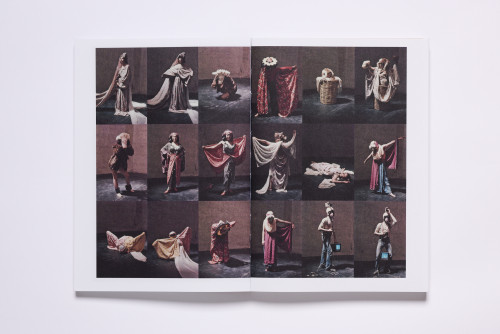

 $45 Purchase ↗︎
$45 Purchase ↗︎From the 1970s until her death, Louisiana-born artist Tina Girouard (1946–2020) was a dedicated experimental artist, collaborator and art worker. Alongside her individual creative endeavors, she nurtured and was a part of numerous influential artist communities and organizations in New York, Louisiana, and Haiti, including the Anarchitecture Group, the interdisciplinary cohort of 112 Greene Street, the restaurant Food, the Kitchen, P.S. 1, and the Festival International de la Louisiane. Her acts of upkeep, including domestic labor traditionally associated with “women’s work,” blurred the boundaries between artmaking and what she called life-making.
Tina Girouard: SIGN-IN is the first comprehensive monograph on her interdisciplinary oeuvre. It gathers documentation of her work in video, performance, drawing, textile, wall works and installation, tracing Girouard’s practice and legacy across genres and geographies, and features an expansive chronology and glossary of terms that emphasize the breadth and depth of her practice.
Edited by Andrea Andersson with Jordan Amirkhani, with new essays by Jordan Amirkhani, Andrea Andersson, Aruna D’Souza, Anaïs Duplan, Pamela M. Lee, and Lumi Tan.
Publishers: Barbara Schoreoder and Karen Kelly
Designers: Julie Peeters and Scott Ponik
384 pages, 240 images, softcover with fold out jacket, 6 1/2 x 9 1/4 inches
ISBN 13: 978-1-954947-19-1
Publication Date: October 16, 2025 (pre-orders available on Dancing Foxes website)
Published by Rivers Institute for Contemporary Art & Thought and Dancing Foxes Press.



 $45 Purchase ↗︎
$45 Purchase ↗︎Convening polyphonous voices from past and present, I Will Keep My Soul is an orchestral layering of photography, historical documents, poetry and interviews, all rooted in the social history, geography and community of New Orleans.
In this prismatic artist’s book, UK-based artist Helen Cammock traverses the city, rendering her observations and encounters into reverberant texts and percipient photographic images that tender the city’s invisible histories. She weaves these contemporary sequences with archival materials from the Amistad Research Center to sustain the city’s complex past. The book object itself—its flexibility, its tactility, its use of transparent paper to layer images and texts—invites the reader into a capacious experience in which multiple and sometimes competing truths can be seen and heard.
Among the newspaper clippings, instructions for activists, a nineteenth-century publication on Creole slave songs that speak the long struggle for Civil Rights, the most persistent historical voice in I Will Keep My Soul belongs to sculptor Elizabeth Catlett whose observations punctuate each section of the book. Cammock also draws on correspondence and photographs that articulate Catlett’s participation in the Civil Rights movement as well as her struggle for agency, autonomy and support during her 1976 commission to create a bronze monument to New Orleans musician Louis Armstrong, sited at Congo Square, a place laden with histories of immense oppression as well as celebration.
The textual contributions by Jordan Amirkhani, Andrea Andersson, and Kristina Kay Robinson are not positioned as traditional art criticism, but instead further deepen the reader’s knowledge, experience and understanding of the opposing forces—geographical, economic, historical, cultural—that have formed the city New Orleans.
Summoning, holding and arranging these voices with extraordinary deftness and acuity, I Will Keep My Soul coalesces into a rhizomatic and particularly American story of art and activism, of culture and capital, of being and belonging.
Reviews and Press
“Hyperallergic’s Art Book Gift Guide”
Staff Writers
Hyperallergic.com
Published December 13, 2023“Review: I Will Keep My Soul Breathes Through Its Skin”
By Elizabeth Zuba
The Diagram
Published November 15, 2023“Art Books: Helen Cammock’s I Will Keep My Soul”
By Briana Ellis-Gibbs
The Brooklyn Rail
Published June 1, 2023“Helen Cammock’s Love Letter to New Orleans”
By Melissa Holbrook Pierson
Hyperallergic.com
Published May 14, 2023“Helen Cammock’s: I Will Keep My Soul interviewed by Kate Wolf”
LARB Radio Hour
Aired April 28, 2023“Featured Artist: Helen Cammock: I Will Keep My Soul at Art + Practice”
Los Angeles Review of Books
Published April 16, 2023“The 6 Best New Books You Should Read This April”
By J. Howard Rosier
Vulture.com
Published April 14, 2023“All Water Has Perfect Memory”
By Jordan Amirkhani
The Paris Review
Published January 31, 2023

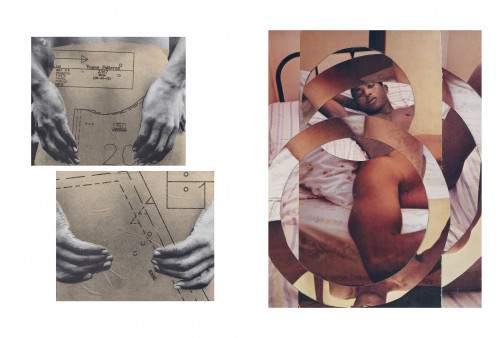

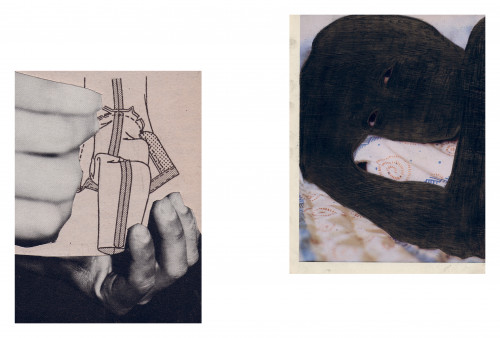 $45 Purchase ↗︎
$45 Purchase ↗︎To tailor a garment by “rock of eye” is to rely on the drape—on experience over mathematical measurement—in the fitting process. It is a kind of drawing in space—a freehand, an intuition, a trust of materials. Rock of Eye, published on the occasion of Troy Montes-Michie’s (born 1985) solo exhibition at the California African American Museum, is a collection of the artist’s collages, drawings, and found and woven images sourced from vintage erotic magazines. These erotic materials are familiar from Montes-Michie’s recent large-scale paintings and collages that center on the Black male body and his series that traces the social history and form of the zoot suit. Troy Montes-Michie was born in El Paso and his practice reflects his experience growing up along the US/Mexico border. His works are studies in ambiguity between portraiture and landscape; his are the cuts and folds of patterning and mapping. In Rock of Eye, Montes-Michie’s stitches suture histories and geographies; they establish thresholds for crossing; his needle hits rock. Including essays by Brent Edwards, Tina Campt, and editor Andrea Andersson, Rock of Eye is a tactile and sensuous artist’s book recalling the form of fabric swatch books and affirming that collage is an art of selection.
“Fugitive Practice: Troy Montes-Michie: Rock of Eye”
By Sharon Mizota
Bomb Magazine
Published March 16, 2022“Zoot Suits, Border Towns, and Collage Works: A Conversation with Troy Montes-Michie”
Interview with Troy Montes-Michie and Jeff Martin
Museum Confidential for Public Radio Tulsa
Aired March 11, 2022“Book of the Week: Troy Montes-Michie: Rock of Eye”
By Laura Larson
Photo-Eye Blog
Published February 21, 2022“Troy Montes-Michie’s Rock of Eye”
By Megan N. Liberty
The Brooklyn Rail
Published February 4, 2022“The Beholder”
By Rasheeda Saka
Alta Journal (Online)
Published December 20, 2021Edited by Andrea Andersson and Lisa Pearson with texts by Tina Campt, Brent Edwards, Andrea Andersson, and an afterward by Cameron Shaw.





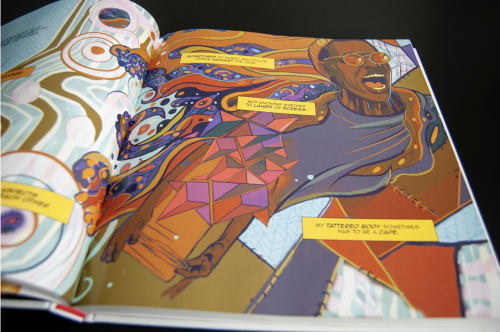 $35 Purchase ↗︎
$35 Purchase ↗︎“What I want to do is code-switch. To have there be layers of history and politics, but also this heady, arty stuff—inside jokes, black humor—that you might have to take a while to research if you want to really get it.”
—Sanford BiggersSanford Biggers (b. 1970) is a Harlem-based artist working in various media including painting, sculpture, video, and performance. He describes his practice as “code-switching”—mixing disparate elements to create layers of meaning—to account for his wide-ranging interests. This catalogue focuses on a series of repurposed quilts (many made in the nineteenth century) that embodies this interest in mixture. Informed by the significance of quilts to the Underground Railroad, Biggers transforms the quilts into new works using materials such as paint, tar, glitter, and charcoal to add his own codes, whether they be historical, political, or purely artistic. Insightful essays survey Biggers’s career, his art in relation to music, and the history upon which the series draws. Also featured is a short yet powerful graphic essay by an award-winning illustrator that introduces the layered meanings inherent in the art and craft of quilting.
Edited by Andrea Andersson and Antonio Sergio Bessa with contributions by Greg Tate, Jacqueline L. Tobin and Raymond G. Dobard, Mia Kang, and John Jennings with David Brame and Esperanza Bey.

Prevenance Suite is a series of “quarantine collages” by poet, scholar, translator and editor Brent Edwards. Interwoven with a series of poems, comprised of fragmentary quotations clipped from a wide range of sources, the work proposes a theory of collage as “prevenance”: a practice that bends and reshapes time through the recombination of print artifacts from different historical sources and moments. For Edwards, the contrapuntal aesthetics of collage is above all a matter of achieving a certain sound.

Passengers Passages, an algorithmic poem by artist and poet Caroline Bergvall, was commissioned by Rivers in the closing months of 2021 and premiered in the November 5 performance of Nattsong for the Estuary Festival at the Turner Contemporary at Margate. In the days bridging 2021 & 2022, this work signaled from our homepage, marking the new year as both a process of sacred waiting and migration. It is a departures board — for all of us moving in between. The work samples the baseline phrase used by the artist, and translated in conversation with bilingual poets, singers, and language warriors in her research into ancient, minorized or prejudiced languages. It is a thread between years, between people, between languages, and between the compositions in Bergvall’s six-year long Sonic Atlas performance cycle.
Sonic Atlas began with the sunrise piece Ragadawn, continued with the conversational Conference with the Birds and online Night & Refuge events and closes with Nattsong, performed at sunset. Join us each evening at sunset (wherever you are) to view a recording of the Nattsong performance. This week it begins daily at 5:05 pm.
Passengers Passages team: Caroline Bergvall (concept, research, source material), John Cayley (javascript coding, animated letteral display), Orange/Revebla (styling and adjustments).

Mother Patchwerk began as a graphic essay, Jennings’ contribution to the publication, Sanford Biggers: Codeswitch (Yale University Press, 2020). This animation recognizes that the logic of the quilt, which stitches part to part, is also the logic that transforms still into moving image. And like quilting, it is a process that involves many hands. Mother Patchwerk is the work of John Jennings with David Brame and Esperanza Bey, stitched together with the sounds of Moon Medicin, and rendered as animation by Daniel Rowe. It is the result of collaboration between Bronx Museum of the Arts and Rivers Institute for Art & Thought.

“We Are Not Responsible” was originally published in Harryette Mullen’s collection Sleeping with the Dictionary (2002). Rehearsing and repurposing the standard rules of linguistic engagement, Mullen mines both Roget’s Thesaurus and The American Heritage Dictionary in a study of the logics and limits of our world. In her book, Mullen absorbs the hierarchical and categorical commitment of Roget and registers the editorial history of the American Heritage, which was compiled with the assistance of a democratic usage panel that included poets Langston Hughes and Arna Bontemps, as well as feminist author and editor Gloria Steinem. Mullen’s writing is a sensual, playful, and heartbreaking demonstration of the constraints of writing and society as much as it is a primer in the art of defiance.

Sanford Biggers: a fractal approach is comprised of twenty quilt works by the artist Sanford Biggers—arranged in a grid, eight squares at its surface, twenty in its depth. By clicking on any square in the grid, the image will advance to the next. Within each square, every work can be navigated from end to end using your cursor.
Known in mathematics as self-similarity, fractal geometry presents as successive magnification or unfolding symmetry. Such is the language of crystals and galaxies, but in the practice of Sanford Biggers, scale is a tool for the discovery of both similarity and inversion. Biggers’ 2007 glass-etching, Lotus, appears from a distance as the Buddhist symbol for enlightenment, but the details of the perfectly symmetrical work reveal lotus petals comprised of bodies in the cargo hold of 18th century slave ships.

Register is a verb, a noun, a poem, a collage, a montage, a soundscape, a polemic, a call to action on the occasion of the 2020 November election. The work was born in the archives of Amistad Research Center, which holds photographs, pamphlets, and manuscripts from the long fight for voting rights in the United States—including the papers of civil and voting rights activist Fannie Lou Hamer (1966–1978). Drawing from material history, Laura Mullen composed a hybrid collaged-based work, voiced by Laura Mullen together with fellow poets Rodrigo Toscano, Ronaldo V. Wilson, and Terri Witek, and given sonic shape by Nathan Davis.
This work was made possible through the partnership between Rivers Institute for Contemporary Art & Thought and the Amistad Research Center. This work is dedicated to Fannie Lou Hamer.

Elinor Carucci: Halfway is a photography essay and oral history by the artist Elinor Carucci spanning twenty five-years of the artist’s practice and three series of work: Closer, Mother and Midlife. Released in the final days of 2020, it is a study on the myth of origins, the courage of women, the politics of domesticity, the intensity of intimacy, the performance of sexuality, the burdens of loving, the agony of growing, the liberation of aging, and the proximity of death. Carucci suspends our gaze at the strange and difficult, familiar and glorious in our family lives. She gives form to a feminist motherhood.
Elinor Carucci: Halfway is accompanied by “Now,” an essay by Jacqueline Rose from Mothers: An Essay on Love and Cruelty (Farrar, Straus, and Giroux: New York), 2018.
The oral history by Elinor Carucci was edited by Aimée Toledano.

Nineteen Notes for Nineteen Flags is occasioned by the nation-wide initiative, Elena del Rivero: Home Address. The latter is a multi-platform installation, defined by nineteen flags designed and suspended across the United States to commemorate the centennial of the Nineteenth Amendment, which legislated women’s right to vote in the United States. Del Rivero’s multiples, emblazoned with a common abstract, geometric pattern also wear the stains of history in recognition of all whose rights were not protected by the landmark legislation—particularly women of color who continue to fight against racial discrimination in voting.
In her work, del Rivero transfers often-overlooked or underestimated textiles from the kitchen into the public sphere. The large-scaled dishtowels rhyme with the geometries of flags commonly on display; they also belong to the artist’s interrogation of geometric abstraction. Her serial exploration locates grids of feminine-coded material culture as antecedents for “vanguard” developments in the male modernist canon. Del Rivero’s flags celebrate the everyday labor invested in the perpetual making of a participatory democracy.
In New Orleans Elena del Rivero: Home Address is presented by Rivers at Tulane University in partnership with Amistad Research Center and at Xavier University in partnership with Xavier’s Center for Equity, Leadership & the Human Spirit. We extend particular thanks to Kara Olidge and Christopher Harter at Amistad Research Center, Ron Bechet and David Robinson-Morris at Xavier University, and Henrique Faria Gallery for your partnership and support in realizing this multi-site endeavor.
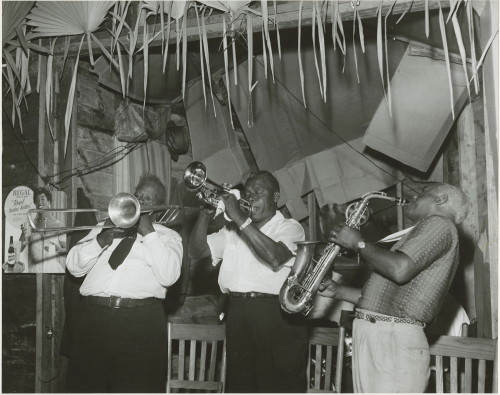
From the Root is an origin story of New Orleans musical culture. It is composed of archival photographs and oral histories and was researched and compiled by Melissa Weber, curator of Tulane University’s Hogan Archive of New Orleans Music and New Orleans Jazz. It is a history in the form of first-person accounts. It is a living history, including a contemporary interview with internationally acclaimed artist Nicholas Payton who speaks to the origins and futures of Black American Music, to those who have sought to control its history, and to the ways it will be liberated.
We give special thanks to the Hogan Archive of New Orleans Music and New Orleans Jazz at Tulane University for permission to reproduce and share archival materials.
We are indebted to the music and storytelling of Billie and DeDe Pierce, Kid Clayton, Avery “Kid” Howard, Manuel Mello, Charlie Hamilton, Peter Bocage, Alex Bigard, Dolly Adams, Lawrence Duhé, & Lester Santiago.